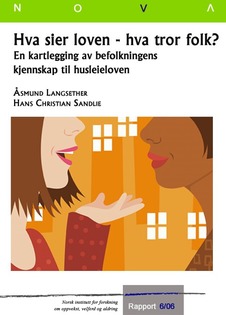| dc.description.abstract | The subject of this report concerns a study to determine how much the public know about the legal dos and donö‚'ts in the rental market. Norwayö‚'s housing policy seeks primarily to ensure everybody has a chance to obtain good, dependable housing. A good place to live and a pleasing neighbourhood come with material, legal, economic and social factors connected with the property and residential area. One of the main strategies employed by the government to achieve this goal involves promoting a well-functioning sales and rental market. The degree of security people enjoy in their living arrangements depends mainly on economic and legal factors. In the legal sense, security is achieved by way of adequate legislation and a judicial system capable of upholding the rights of residents. But the intentions of the legislature and society can not be translated into practice unless the various parties in the housing market are familiar with the relevant statutes and provisions. This is particularly the case in the rental market. Because of the structural nature of the Norwegian rental market, the authorities are faced with particular challenges to identify what people need to know about the provisions in the Tenancy Act, and get the message across. Both the supply and demand sides of the Norwegian rental market are unusual inasmuch as private individuals do most of the supplying, either by letting space in their own home (frequently a basement flat), or a second home if they own one. About 20 per cent of Norwayö‚'s population aged 15-60 report having let property at some time. The percentage rises with age, with 30 per cent of individuals aged 50 and over having let property. About 20 per cent of Norwegian households (in absolute numbers, that is about 400,000 households) occupy rented property. Earlier studies have shown, however, that the rental market is increasingly the province of people going through periods of change or instability, such as young adults starting a family or people involved in separations following the break down of a relationship. This way of using the rental market means that most people in Norway have lived in rented accommodation at least once in their lives. Indeed, as much as 75 per cent of people aged 20-60 say they either live in rented property at the moment or have done so previously. An Internet-based questionnaire was used to gather the data. Respondents were asked to say whether they believed assertions about different aspects of the Tenancy Act were right or wrong. The areas of the Act we chose to concentrated on were selected together with officials from the Ministry of Local Government and Regional Development. The sample counted 805 persons aged 15-60. Given the low number of "donö‚'t knowö‚» answers, it appears that most people feel they know something about the provisions of the Act. The "donö‚'t knowö‚» box remained unticked by almost half of the sample whatever the statement they were asked to consider; and about 90 per cent felt they knew the correct answer to half or more of the statements. The area of greatest uncertainty were related to the following points: the right of landlords to demand rent in advance; whether the statutes specify a minimum period rental agreements for a specified time must adhere to; and time limits and procedures involved in the termination of tenancy agreements. We also found that younger respondents still residing at home with their parents were significantly more likely to feel uncertain than the sample in general. For this reason, we excluded this group from the subsequent analyses. The areas about which people appear to be most familiar are the scope of the law, and the general provisions relating to tenancy agreements (contracts). To take an example, 80 per cent know that the Act applies to both non commercial and commercial landlords alike, and the letting of accommodation in private homes. Over 70 per cent know that tenants have aright to demand a written agreement if they so desire. The provisions people tend to know less about - i.e. where fewer respondents give the right answer and more the wrong answer - relate to agreement termination procedures; minimum legal tenancy period; and the right of landlords to insist on both a deposit and a guarantee (security) for rent owed. More than half believe, for instance, that the law is silent about the minimum period a tenancy agreement is legally valid, and only 30 per cent know that landlords are within their rights to demand both a deposit and a guarantee. Generally speaking then, it seems slightly alarming that the public are ignorant about such important aspects of tenancy agreement law. No group stands out with either superior or inferior knowledge. That said, young tenants over 20 do tend to have a better grasp of the details of the law than other groups. While the need for information on the Act and its various provisions varies according to subject area, there are significant gaps in certain major areas. The survey asked respondents where they would go for information about their rights under the Tenancy Act. Responses highlighted the Internet, National Association of Home Owners and Tenantö‚'s Organization. There are significant age-related differences, here, however. Older people are more likely to call the Home Ownersö‚' Association, the Tenantö‚'s Organization or the regional offices of the Consumer Council of Norway, while younger respondents are more likely to prefer informal routes such as Internet searches or asking the advice of friends or work colleagues who know more than themselves. | en |
